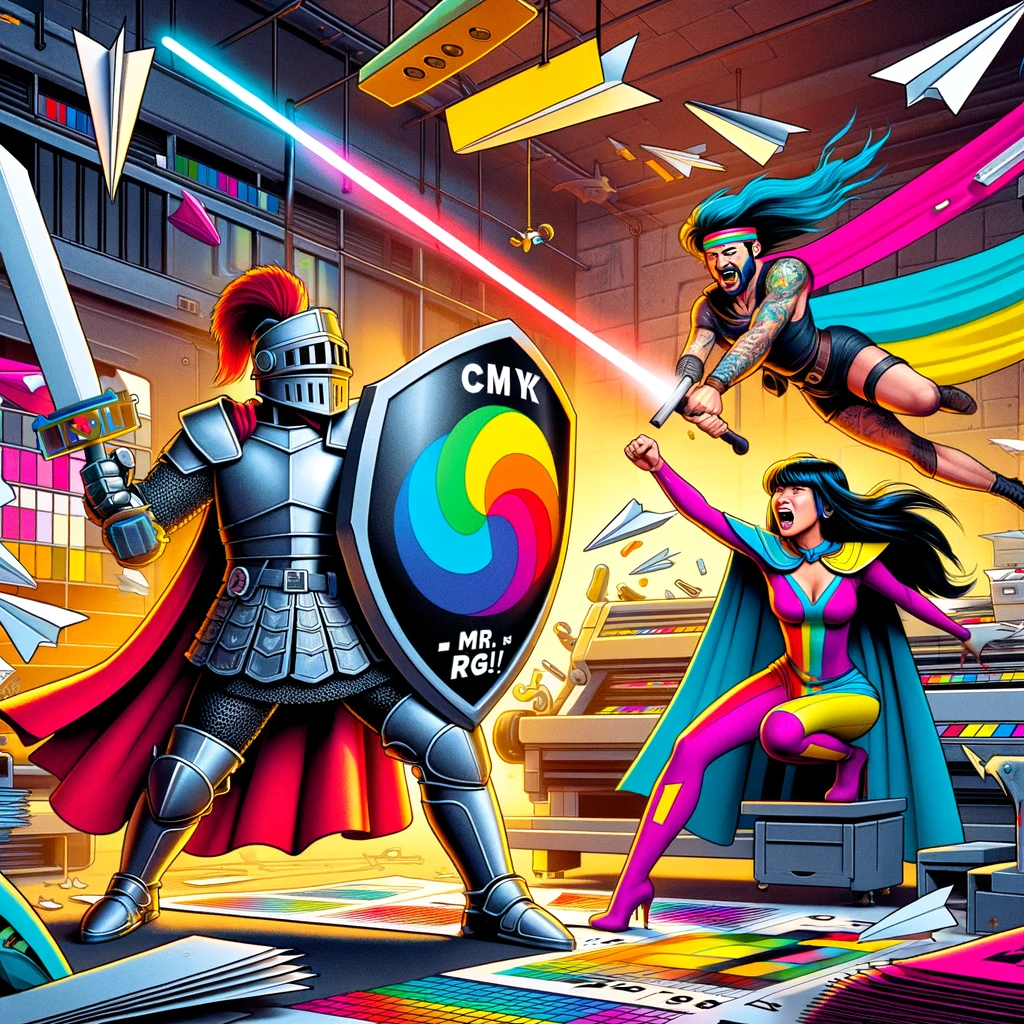W jednym z poprzednich artykułów wspomniałem żartobliwie, ze dla „profesjonalnego grafika DTP” RGB jest jak pytanie nowego stażysty w dziale – nie do końca poważne i fachowe. Cóż oczywiście sytuacja ta jest przekoloryzowana, ale istotnie konflikt na linii CMYK – RGB istnieje. Wyjaśnijmy sobie zatem czym Ci dwaj Panowie się różnią, dlaczego jeden uznawany jest za większego profesjonalistę i co dalej z nimi będzie… choć marny ze mnie wróżbita.
Zacznijmy od oczywistości
RGB to model barw wywodzący się z fizycznego postrzegania światła widzialnego – mamy tu zatem trzy składowe (Red, Green, Blue) reprezentujące najbardziej podstawowe (generyczne – dla programistów) barwy. Każda ze składowych tego koloru może przybrać wartość 0-255 dając w ten sposób 16,7 miliona kombinacji. Model ten to tzw model addytywny – w skrócie wartości 0 dla każdej składowej dadzą nam kolor czarny, maksymalne – biały.
CMYK będzie zatem nieco różny – nie bazuje na fizycznym postrzeganiu światła, a na pigmentach poligraficznych (Cyan, Magenta, Yellow, blacK) będąc tym samym znacznie bardziej przystosowanym pod druk. Jego składowe przyjmują wartości 0-100 dając mniej kombinacji niż RGB, ale pozwalającym uzyskać „lepsze” żółcie i błękity („czystsze, pełniejsze kolory”). Jest to model substraktywny – przeciwnie do RGB wartości 0 0 0 0 dają kolor biały, cztery „setki” owocują natomiast czerń.
Skąd popularność w poligrafii
Przecież to nie tak ze ktoś kiedyś powiedział, że tak jest i koniec… Poza powodem o którym wspomniałem powyżej CMYK to takze w miarę prosta i bezkonfliktowa translacja do popularnego Pantone’a, czego nie da się powiedzieć o RGB. Kolejny powód związany jest z łatwością druku – ponieważ składowe CMYK odpowiadają popularnym pigmentom poligraficznym łatwiej jest przygotowywać przy pomocy tego systemu kolory. Ze względu na brak konieczności translacji kolory te są także zgodne z oczekiwaniami (to znaczy porównując kolor CMYK na profesjonalnym monitorze z wydrukiem uzyskamy identyczny obraz, w przypadku RGB obraz ten będzie różny). Na koniec – technika druku – ze względu na swją charakterystykę druk przy użyciu CMYKa odbywa się poprzez nakładanie na siebie kolejnych warstw składowych – bez konieczności mieszania farb.
System idealny?
Nie do końca… Pomijając fakt, ze prawie nikt nie posiada w domu profesjonalnego, skalibrowanego wyświetlacza CMYK, więc prawie nikt nie jest w stanie poprawnie zwizualizować sobie takich kolorów problemem dla drukarni stał się sam sposób druku. Aby zagwarantować wcześniej opisywany brak konieczności mieszania barw należy drukować kolor w tak zwanym rastrze – jeśli chcemy nadrukować pół przezroczysta żółć nie rozcieńczamy żółci do połowy nasycenia a drukujemy je w formie „szachownicy” (konkretnie w formie kropek których rozkład oddaje nasycenie koloru – możemy to osiągnąć choćby poprzez sterowanie rozrzutem jednakowej wielkości kropek [stochastyczny] czy też sterowanie wielkością kropek [amplitudowy], choć de facto nie musza być to kropki). Znaczenie ma także sposób łączenia wzorów – te trzeba nakładać pod odpowiednim kątem by uniknąć efektu mory (prążków Moire) – optycznego nakładania się kropek w wyniku którego na obrazie pojawiają się wyraźniejsze pręgi kolorystyczne.

To może jednak RGB?
Przecież lepiej odzwierciedla światło widzialne, jest bardziej „naturalny” i ma więcej kombinacji koloru… Rozumowanie słuszne – i znalazło swoje ujście, ale nie do końca. RGB przeżywa swoją drugą młodość pojawiając się coraz częściej jako dopełnienie kolorów CMYKowych w profilach kolorystycznych nowszych sprzętów. Jednak to rozwiązanie jest stosunkowo mało popularne, drogie i ograniczone do jedynie niektórych metod druku, jednak daje najlepsze efekty łącząc precyzję CMYKa z bogactwem kolorów RGB. Jednak i sam RGB nie jest skazany na porażkę – gdyż wykorzystywany jest często w tak zwanych cyfrowych metodach druku.
Kto wygrał?
Nikt. Choć często podkreśla się swoistą „rywalizację” miedzy oboma modelami, tak naprawdę oba koegzystują ze sobą od lat trzymając się zasady: RGB – wyświetlacz, CMYK – druk. W ten sposób użytkownicy wszelkiej maści elektroniki cieszyć się mogą żywymi barwami, odbiorcy grafik zaś cieszyć się mogą precyzją barwną i „czystością” barw oraz zgodnością wydruku z projektem nawet w przypadku druku Pantone. Stratni są jedynie graficy skazani na operowanie między oboma przestrzeniami, przeklinając często ich różnorodność 🙂

